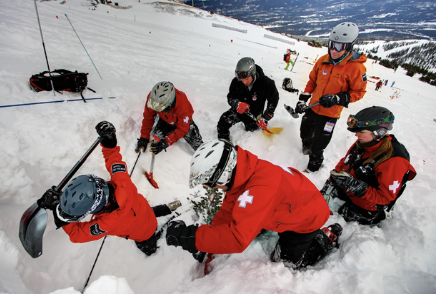Avalanche: Worst Case Scenario

If you or a friend are caught in an avalanche, it's crucial to act quickly and follow these steps for locating and recovering the buried individual(s):
Stay Calm: as challenging as it may be, try to remain calm to assess the situation and make rational decisions.
Watch and Listen: keep an eye on the avalanche path and listen for any signs of survivors calling out for help. They may have been partially buried and could still be conscious.
Signal Search: If you have avalanche transceivers, switch them to search mode immediately. Check for signals from the buried person(s) and start searching in the most likely areas based on avalanche dynamics and the last seen point.
Organize a Search: If multiple people are present, organize a systematic search. Assign roles such as probing, shoveling, and maintaining visual contact with the area being searched.
Probe: Use avalanche probes to systematically probe the snowpack in the areas where the buried person(s) are likely to be located. Probe in a grid pattern with overlapping coverage.
Shovel: Once a buried person is located with a probe, start shoveling immediately. Time is of the essence and every second counts. Clear snow away from the victim's face and airways first.
Perform Basic First Aid: Assess the condition of the buried person(s) and provide any necessary first aid. Check for airway obstructions, breathing, and circulation. Administer CPR if needed.
Extract and Evacuate: Once the buried person(s) are uncovered, extract them from the snow as quickly and gently as possible. Evacuate them to a safe location and seek medical attention immediately.
Continue Search: If multiple people are buried, continue the search until everyone is located and recovered. Even if someone is found, there may still be others buried nearby.
Report and Document: Report the incident to the appropriate authorities and provide as much detail as possible about the location, number of victims, and any other relevant information. Document the incident for future reference and analysis.
Avalanche rescue is a team effort and every second counts! Stay focused, communicate effectively, and work together to increase the chances of a successful rescue.

Train for the worst-case scenario BEFORE it happens:
Ortovox is a well-known brand that specializes in manufacturing outdoor equipment, particularly focusing on avalanche safety gear such as avalanche transceivers, probes, shovels, and avalanche airbags. It also offers educational resources and training programs to promote avalanche safety awareness and provide individuals with the necessary knowledge and skills to stay safe in the mountains.
This safety training typically covers a range of topics related to avalanche awareness, backcountry travel, and rescue techniques, including:
Avalanche Awareness: the basics of avalanche formation, terrain assessment, and recognizing avalanche terrain features. This includes understanding avalanche danger ratings, snowpack stability, and weather conditions that contribute to avalanche risk.
Transceiver Training: how to properly use avalanche transceivers (also known as avalanche beacons) to locate buried avalanche victims. This involves practicing search techniques, signal acquisition, pinpointing, and conducting mock rescue scenarios.

Avalanche Rescue Techniques: instruction on efficient and effective avalanche rescue procedures, including probing and shoveling techniques. Participants learn how to organize and execute a rescue operation in the event of an avalanche burial.
Companion Rescue: emphasizing the importance of teamwork and communication in backcountry travel. Participants learn how to work together as a cohesive team to mitigate avalanche risk and respond to emergencies effectively.
Backcountry Travel Skills: guidance on route planning, decision-making, and risk management while traveling in avalanche terrain. This includes understanding safe travel protocols, terrain selection, and navigation techniques.

Ortovox safety training programs include in-person workshops, online courses, and educational videos. The programs are designed to cater to individuals of all skill levels, from beginners to experienced backcountry travelers, and aim to empower you with the knowledge and confidence to make informed decisions and mitigate avalanche risk effectively.
https://www.ortovox.com/hr-en/safety-academy/training/avalanche-courses
This type of avalanche safety training is highly recommended if you plan to venture into the backcountry during the winter months. You’ll be equipped with essential skills and the necessary awareness to enjoy the mountains safely and responsibly.
